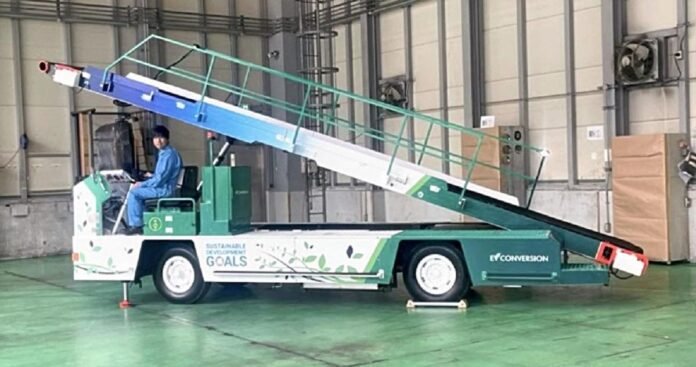A converted EV belt charger from the ANA Group is on display in Tokyo’s Ota district in May.
13:47 JST, July 2, 2024
Since service vehicles are responsible for almost 10% of airport CO2 emissions, there is an increasing effort to decarbonise airports.
There are currently about 13,000 airport vehicles in use nationwide, most of which run on diesel. Electric vehicles and other types of zero-carbon vehicles account for only 6% of all airport vehicles in Japan.
ANA Motor Service Co., part of the ANA Group, announced in May that it had converted one of its diesel belt loaders into an EV. The charger was used to transport luggage on and off airplanes and was originally intended for disposal. It can now be charged from a general electrical outlet.
The energy source for all operations, such as driving and loading and unloading cargo, is switched from diesel to electricity.
Because most electric utility vehicles are manufactured in other countries, there are concerns about their maintenance, and rising prices due to the weak yen also hinder their wider use in Japan.
“Decarbonization is the mission of the entire aviation industry. We want to contribute to that goal,” said an ANA Motor Service official. The company will convert more diesel vehicles to electric vehicles in the future.
According to the Ministry of Land, Infrastructure, Transport and Tourism, electric service vehicles are being used at Haneda Airport to load, unload and transport baggage and cargo in areas restricted to airport personnel. Six EVs are reportedly being used to determine the total amount of electricity consumed and the facilities and equipment needed to operate them.
In addition, the use of these electric vehicles is expected to result in a CO2 reduction of 22 tonnes per year.
At Shizuoka Airport, long-distance vehicles have been replaced by electric vehicles to determine the travel distance of each vehicle on a normal charge, as well as how long it takes to charge them. Whether fast charging with special equipment is needed will also be determined.
At Kumamoto Airport, electric vehicles are used as inspection vehicles for navigation lights. These vehicles have been in use for about 20 years.
The large amounts of CO2 emitted by the aviation industry have led to fierce criticism abroad, expressed in the term ‘flight shame’. This year, British Airways announced that more than 90% of its vehicles at London’s Heathrow Airport would be replaced by electric vehicles and other vehicles running on synthetic fuels.
Many countries are accelerating their efforts to reduce carbon emissions from airports, a top transport ministry official said, amid concerns that a delay in decarbonising some airports could lead to airlines ceasing to use them.
There are still many challenges ahead. For example, because airports currently do not have additional power capacity available, switching all service vehicles to electric vehicles will require airports to make major investments to upgrade transmission lines and other facilities.



